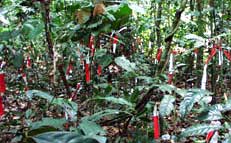 |
|
 |
| |
Phytosociology: |
|
| |
|
|
| |
 The evergreen tropical lowland rainforest shows not
only a high species diversity but also a high diversity of
plant communities. We identify plant communities and study
their characteristics, relationships and distribution from
plot- to landscape-level. The evergreen tropical lowland rainforest shows not
only a high species diversity but also a high diversity of
plant communities. We identify plant communities and study
their characteristics, relationships and distribution from
plot- to landscape-level.
Biodiversity is considered as an important measure
for the evaluation of ecosystems. However, the factors that
dertermine species composition remain unknown, unless we identify
plant communities, and study their characteristics, dynamics
and interactions. Only an evaluation of the heterogeneity of
vegetation in time and scale will help us to develop applicable
plans for protection and management. |
|
| |
|
|
| |
|
|
| |
Setup: |
|
| |
|
|
| |
Data collection in plots across different habitat
types (Plot size: 50x50m – 3x5m, depending on habitat
type and research question) |
|
| |
|
|
| |
Habitat Types |
|
| |
|
|
| |
1. Heterogenous primary forest
- on terra firma soil
- periodically inundated
- permanently inundated
|
|
| |
|
|
| |
 |
|
| |
Heterogenous primary forest: |
on terra firma soil |
periodically inundated |
permanently inundated |
|
|
| |
|
|
| |
|
|
| |
|
|
| |
2. Homogenous primary forest
- Monopetanlanthus pteridophyllus on sandy soil poor
in humus
- Gilbertiodendron dewevrei on terra firma soil
- Brachystegia on terra firma soil
|
|
| |
|
|
| |
 |
|
| |
Homogenous
primary forest:
|
Monopetanlanthus
pteridophyllus on sandy soil poor in humus
|
Gilbertiodendron
dewevrei on terra firma soil
|
Brachystegia
on terra firma soil
|
|
|
| |
|
|
| |
|
|
| |
|
|
| |
3. Secondary forest |
|
| |
|
|
| |
 |
|
| |
secondary
forest around settlements
|
fast-growing
heliophilous plants
(e.g. Musanga sp.)
|
often with
mechanic defence mechanisms such as spines or thorns
(e.g. Anchomanes sp., Zanthoxylum sp.)
|
|
|
| |
|
|
| |
|
|
| |
|
|
| |
4. Savannah
- Dry (Esobe)
- Wet or inundated (Libeke)
|
|
| |
|
|
| |
 |
|
| |
Savannah:
|
Dry (Esobe)
|
Wet or
inundated (Libeke)
|
|
|
| |
|
|
| |
|
|
| |
|
|
| |
Forest ecosystems can be characterized in a vertical (vegetation
stratification) and in a horizontal dimension (distribution
of plant communities). |
|
| |
|
|
| |
|
|
| |
|
|
| |
|
|
| |
|
|
| |
|
|
| |
|
|
| |
|
|
| |
|
|
| |
|
|
| |
|
|
| |
|
|
| |
|
|
| |
|
|
| |
|
|
| |
|
|
| |
|
|
| |
|
|
| |
|
|
| |
|
|